British No 4 (T) Sniper Rifle ……………..SOLD
Created on July 26th 2013
British Number Four (T) Sniper Rifle
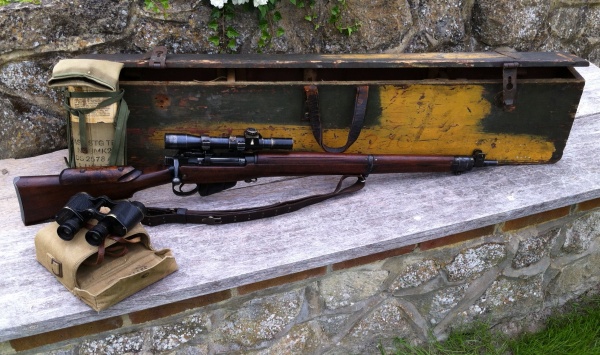
A good example of the famous Number Four T in its transit case with scope and soft carrying case, leather adjustable sling, binoculars and case. The rifle is a M47C, war time production BSA Shirley model.
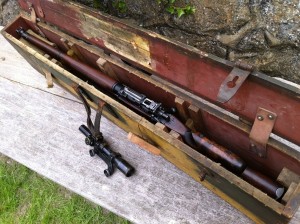
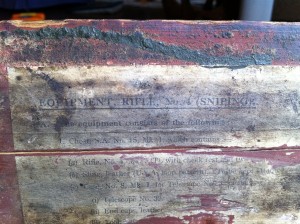
The Transit Case.
Measuring: 46.1/2″ in length, by 5″ in width, by 10.1/4″ in height. It is constructed with dovetail joints on each corner from a low grade packing-case timber which is of .5/8″ thickness. It was painted originally in an Olive drab color with white stenciling, which would have detailed the chest part number and the rifle number. All this detail has been obscured by yellow (possibly desert paint) with a paintbrush in a typically brursk manner. It is possible to just make out the white stenciling underneath the yellow on top, but not to read it. The inside of the chest is the correct dull red found on most of the chests with the original directions and parts list paper label pasted to the inside of the lid. This label has suffered reassuring wear from the rifle inside the box. The leather hinges which retain the box lid look to be very professional replacements if not armory items. The two retention blocks which hold the rifle in position and, are retained themselves on string are in position. As, is the swinging peg which keeps the scope container in place. The two external swinging latches which hold the box closed are fixed to the lid and present but, one of the rotating staples on the front is missing. The original leather carrying straps are in position and quite serviceable. The case in all, is a 100%-er.
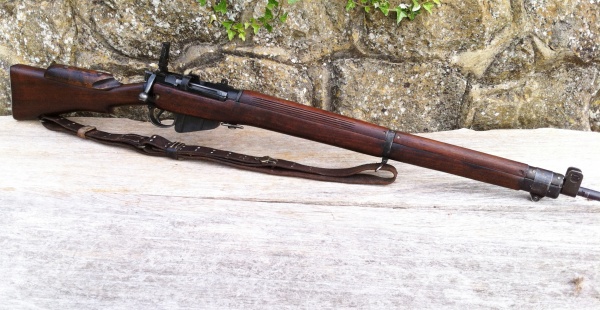
The Rifle.
British, Number Four (T) .303 rifle, with detachable ten round box magazine. Measuring 44″ in overall length. The round blued barrel is 25.1/4″ long. The butt-stock is of standard length, giving the weapon a trigger pull length of exactly 13″ from center to center. There is .1/8″ of free play when the trigger is at rest. All the metal work is blacked and the stock made from dark walnut timber apart from the screw-on cheek-piece. The cheek piece appears to be of the silk-wood used on some number five jungle carbines.
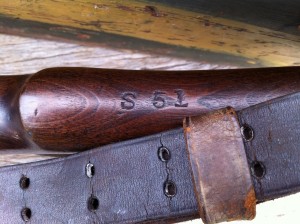
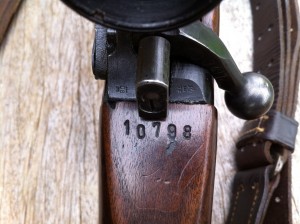
The butt-stock has the correct grey metal butt-plate with trap for cleaning equipment and oil bottle. The cheek-piece attached to the comb by two wood-work screws raises the shooters eye-level to bring it into line with the scope. The stock is marked with the “S 51” Holland & Holland mark just behind the semi-pistol grip. The rear sling swivel is attached on the lower end of the stock. There are some Enfield inspection stamps on the underside of the grip and the broad arrow of the War Department, these are just behind the trigger guard. On-top of the wrist, partially obscured by the cocking piece is a number clearly impressed into the stock, “10798” – this is the serial number of the scope. On dis-assembly of the butt-stock it is noted that the correct rifle number is on the internal shoulder of the stock.
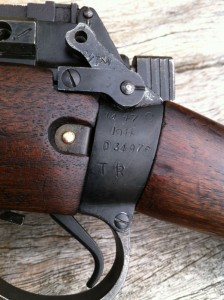
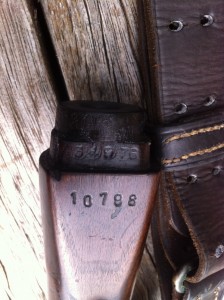
The LHS butt-socket is marked as follows; ” M 47 C / 1944 / D 34976 / T R. ” All correct markings; The M47C was BSA Shirley’s manufacturing code, followed by date of manufacture, the serial number and “TR” indicating the “T” conversion. The other side of the socket is bare. The LHS of the action is clearly marked with a “T” then under that, if carefully studied, it is possible to see “No 4. Mk I”. The other side of the action just bears the single “S” stamp which indicates the rifle did not need re-zeroing after conversion at Holland & Holland. The “M47C” is repeated again in-front of the magazine, behind the mid-point sling swivel, along with an “R”.
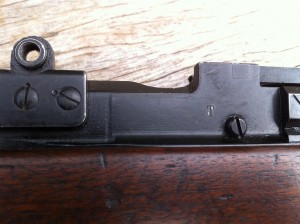
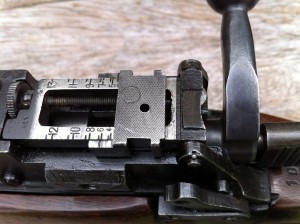
The mounting blocks for the scope are fixed to the action side wall as part of the conversion by a total of five screws, these were finally staked into position with a center punch, to stop movement under recoil. Another tell tale sign of a genuine sniper is the absence of the “open” or “battle sight”. This was done in factory and it is possible to see on close inspection the milling marks underneath the re-blue, where the aperture was originally mounted. The purpose of this operation was to provide clearance for the mounting of the scope. ( The rear aperture sight has to be in the elevated position to remove the bolt, consequently, the scope has to be removed) The aperture sight is graduated from 2 to 1300 yards and is marked “N67” on the facing surface at the top and “S.M” on one side and “broad arrow” on the other. Adjustment is by a wheel on top of the unit, which is smooth and positive, there is no windage on the rear sight. At the rear of the action, the two slopes on either side of the bolt channel have clear Enfield inspection marks on them. The breech is devoid of any markings and has the gas escape hole on the LHS just above the level of the wood-work.
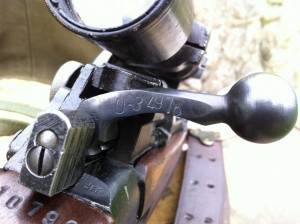
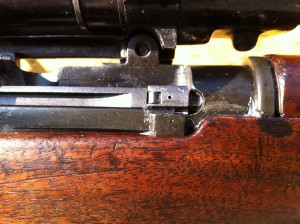
The bolt is numbered to the gun on the rear of the handle. It has the correct rectangular cocking piece and has a slightly worn patina to the handle and bolt knob suggesting some use. The safety catch mounted on the rear of the LHS of the action is marked “M47C” and functions correctly. Bolt operation is smooth and main spring resistance still strong. Moving forwards along the length of the rifle, the hand-guard is fluted and the mid barrel band is clearly marked on top with the manufacturers code “S.126”. The front band has some corrosion upon it but has retained color. The correct fore-sight protection ears are in position and the barrel has the bayonet lugs fitted in-front of the sight unit. The crown is even and does not seem to have suffered from “pull-through wear“.
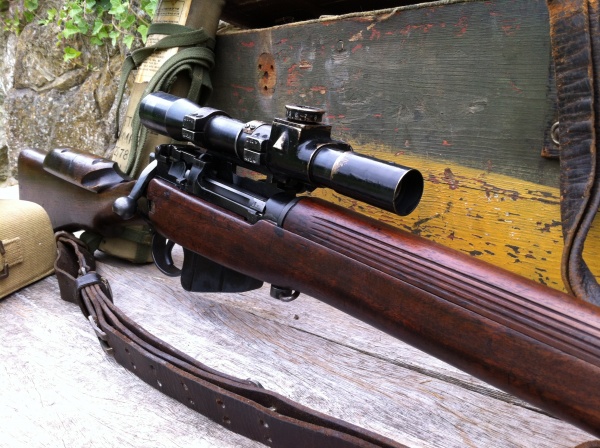
All over, the wood work seems to bear the same tone of color and amount of wear. There are the usual scratches and dents in the rifle expected on an item which has suffered military use. The metal has the mixed finish expected on any Enfield with the most wear on the high points and the bolt head. There is a Parker-Hale swiveling mid-length sling swivel which is vacant at the moment. Attached to the other two sling swivels is the original, leather, Springfield 1903 type adjustable sling. It has the dual brass claws and double rows of holes with multiple points for every size of user. The sling is supple and has been well maintained but is starting to crack from age. There is a small amount of verdigris on the fixing rivets. There is a set of initials referring to the maker but it is difficult to make out; best guess, ” B.T. & B. Co / 8 ” I would suggest replacement with a re-pro unit if the rifle is to be used. The bore is good, usage will clean it up.
The Scope & Mount.
The scope is the standard No 32 Mk 2. The top of the scope is marked as follows; ” TEL. STG. No 32 Mk __ / H.B.M. Co O.S. 1650 / REGD No 10798 / broad arrow ” The H.B.M & Co is the name of the maker ( Houghton, Butcher Manufacturing Company). The scope has the staggered turrets for adjustment of elevation and windage. There are no other markings on the actual scope. It is 11″ long, has a 1″ tube and no sliding covers or sunshade. The optics are excellent and clear with no internal dust floating around. Adjustment is positive and free on both drums. It appears there has been no interference with any of the screw heads, either on the scope or the mount caps. All screws seem un-buggered. There is a light brown pair of leather scope covers with a broad arrow marked on the thin joining strap. The reason it is unclear on what Mark it is exactly is that the rear mount cap is obscuring the engraving. The scope has the conventional No32 single post dissecting a horizontal rail, this is needle sharp.
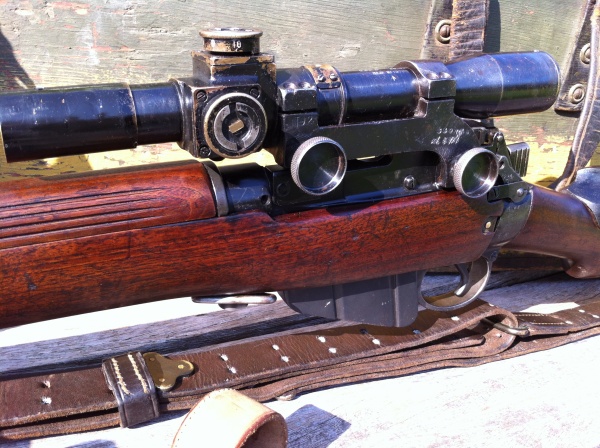
The mount itself is typically rough. It has two large diameter screws which allow fixing to the pads on the action sides. Each of the screws has a sprung locking washer underneath its head. The external surface of the cast mount is rough to the touch on the underside, the facing surface has been milled or filed flat and the number of the rifle applied. Interestingly enough there was a previous number on the mount and this has been struck out and the new number applied. There is also a clear “N 92” applied to the same external surface of the mount. There are four “staked” screws to each post cap, all appear undisturbed. On the reverse side of the mount and scope are the matching alignment numbers, placed there to avoid mixing up if the scope were ever removed, they are “R 513” and “R 514”. Once again the finish is mixed over brass, which has worn through in many places. The fit to the rifle is perfect and secure once the main fixing screws are secured into position.
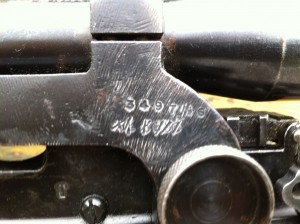
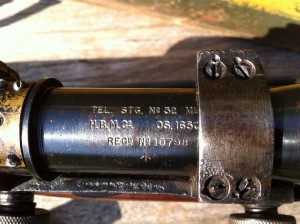
The scope container is one of the lesser seen “soft” type. It is constructed of a tin type open inner flattened tube which is wrapped in canvass. There is a web bucket and strap in which the case sits which is green and an instruction label on the outside. On the front lower part is printed the following; ” broad arrow / CASE STG TEL / NO 8MK2 OS 2578 A / L & J.W. LTD ” This is in very good condition. Inside the transit case is a regular military canvass sling which is very “period”.
Binoculars & Case.
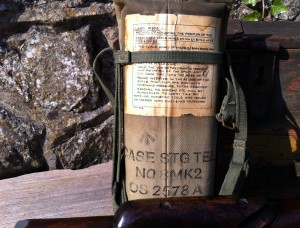
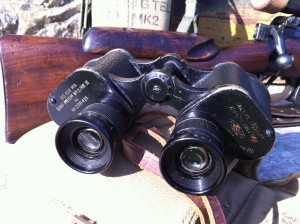
Along with all the other items in this transit case comes a pair of military spotters binoculars, which are dated 1943. They are of 6 x magnification and have the horizontal scale in the right eye-piece. On top of the left hand prism casing is printed the following; “OS 108 MA / BINO PRISM No 2 MK II / x 6 / No 200421 ” On top of the RHS prism casing is some technical information about the graticules over the makers name “KERSHAW” and the date 1943 / OS 108 MA.” The eye-pieces are graduated and help focus the glasses and they pivot about the center for different eye spacing. They still have their brown leather strap. Interestingly there is a webbing case for the glasses, which they fit perfectly into. At the object end the binoculars are marked with the broad arrow of the War Department.
FOOTNOTE: The rifle had to be stripped down to be cleaned and assessed. Apart from finding matching numbers on the shoulder of the butt-stock some more information was discovered when the front end was removed: Matching numbers stamped into the barrel know form, on the side, and interesting armorers marks under the barrel near the knox form.
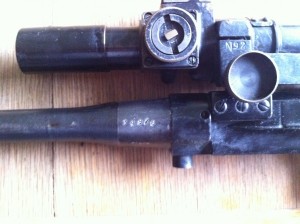
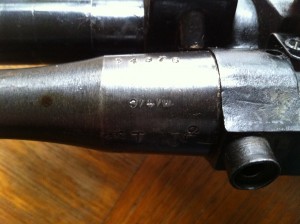
In conclusion, this is a nice set which would be just as at home in a serious military rifle collection as it would be out on the range. These items are becoming hard to find now so to find a rifle with some obvious history within its make up is a satisfying acquisition. Needless to say there are other item to add to the kit to make it complete, but the hard work has been done – it just needs finishing off now.
Stock No’ f 356
£ 4500.
Comments Off on British No 4 (T) Sniper Rifle ……………..SOLD